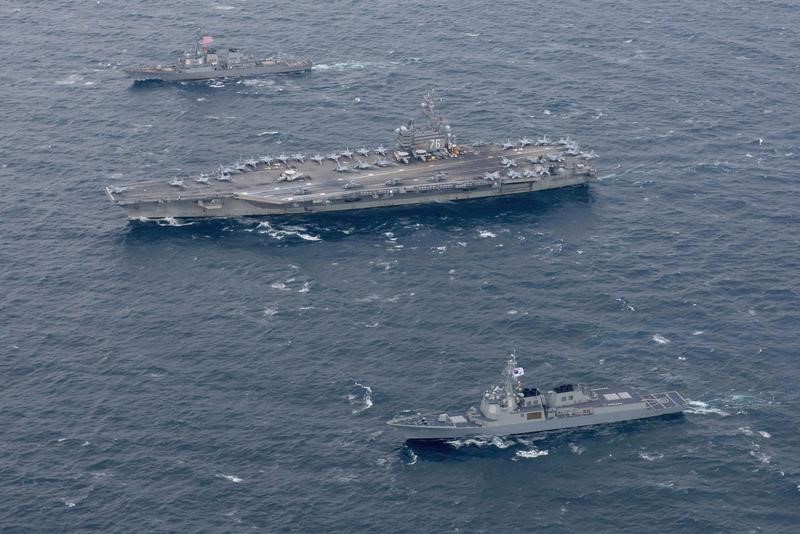
By Tim Kelly
ABOARD USS RONALD REAGAN, Sea of Japan (Reuters) – The USS Ronald Reagan, a 100,000-ton nuclear powered aircraft carrier, patrolled in waters east of the Korean peninsula on Thursday, in a show of sea and air power designed to warn off North Korea from any military action.
The U.S. Navy’s biggest warship in Asia, with a crew of 5,000 sailors, sailed around 100 miles (160.93 km), launching almost 90 F-18 Super Hornet sorties from its deck, in sight of South Korean islands.
It is conducting drills with the South Korean navy involving 40 warships deployed in a line stretching from the Yellow Sea west of the peninsula into the Sea of Japan.
“The dangerous and aggressive behavior by North Korea concerns everybody in the world,” Rear Admiral Marc Dalton, commander of the Reagan’s strike group, said in the carrier’s hangar as war planes taxied on the flight deck above.
“We have made it clear with this exercise, and many others, that we are ready to defend the Republic of Korea.”

The Navy’s forward-deployed aircraft carrier USS Ronald Reagan and the forward-deployed Arleigh Burke-class destroyer USS Stethem steam alongside ships from the Republic of Korea Navy in the waters east of the Korean Peninsula on October 18, 2017. Picture taken on October 18, 2017. Courtesy Kenneth Abbate/U.S. Navy/Handout via REUTERS
The Reagan’s presence in the region, coupled with recent military pressure by Washington on Pyongyang, including B1-B strategic bomber flights over the Korean peninsula, comes ahead of President Donald Trump’s first official visit to Asia, set to start in Japan on Nov. 5, with South Korea to follow.
North Korea has slammed the warship gathering as a “rehearsal for war”. It comes as senior Japanese, South Korean and U.S. diplomats meet in Seoul to discuss a diplomatic way forward backed up by U.N. sanctions.
The U.N. Security Council has unanimously ratcheted up sanctions on North Korea over its nuclear and ballistic missile programmes since 2006. The most stringent include a ban on coal, iron ore and seafood exports that aim at halting a third of North Korea’s $3 billion of annual exports.
On Monday, Kim In Ryong, North Korea’s deputy U.N. envoy, told a U.N. General Assembly committee the Korean peninsula situation had reached a touch-and-go point and a nuclear war could break out at any moment.
A series of weapons tests by Pyongyang, including its sixth and most powerful nuclear test on Sept. 3 and two missile launches over Japan, has stoked tension in East Asia.
A Russian who returned from a visit to Pyongyang has said the regime is preparing to test a missile it believes can reach the U.S. west coast.
On Sunday, Secretary of State Rex Tillerson said President Donald Trump had instructed him to continue diplomatic efforts to defuse tension with North Korea.
Washington has not ruled out the eventual possibility of direct talks with the North to resolve the stand-off, U.S. Deputy Secretary of State John J. Sullivan said on Tuesday.
(Reporting by Tim Kelly; Editing by Clarence Fernandez)

